Attached files
| file | filename |
|---|---|
| 8-K - FORM 8-K - CARVER BANCORP INC | c15084e8vk.htm |
Exhibit 99.1

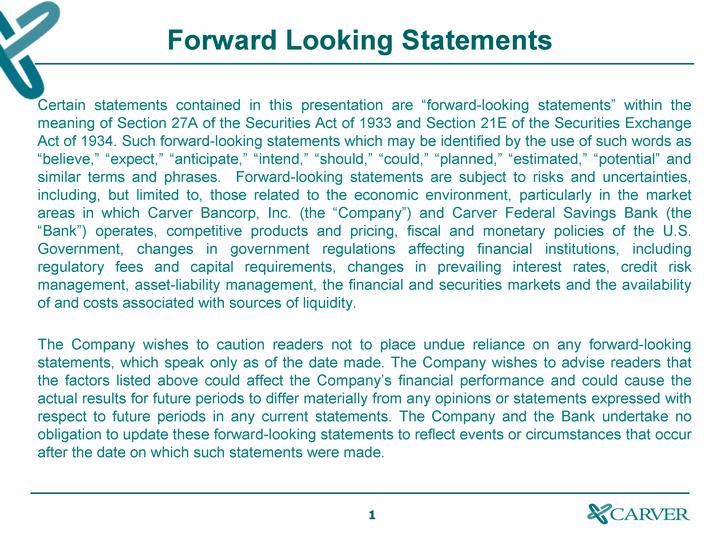
| Certain statements contained in this presentation are "forward-looking statements" within the meaning of Section 27A of the Securities Act of 1933 and Section 21E of the Securities Exchange Act of 1934. Such forward-looking statements which may be identified by the use of such words as "believe," "expect," "anticipate," "intend," "should," "could," "planned," "estimated," "potential" and similar terms and phrases. Forward-looking statements are subject to risks and uncertainties, including, but limited to, those related to the economic environment, particularly in the market areas in which Carver Bancorp, Inc. (the "Company") and Carver Federal Savings Bank (the "Bank") operates, competitive products and pricing, fiscal and monetary policies of the U.S. Government, changes in government regulations affecting financial institutions, including regulatory fees and capital requirements, changes in prevailing interest rates, credit risk management, asset-liability management, the financial and securities markets and the availability of and costs associated with sources of liquidity. The Company wishes to caution readers not to place undue reliance on any forward-looking statements, which speak only as of the date made. The Company wishes to advise readers that the factors listed above could affect the Company's financial performance and could cause the actual results for future periods to differ materially from any opinions or statements expressed with respect to future periods in any current statements. The Company and the Bank undertake no obligation to update these forward-looking statements to reflect events or circumstances that occur after the date on which such statements were made. Forward Looking Statements |

| Agenda Overview Near Term Outlook Division Highlights: Opportunities Ahead Questions and Answers Review of Financial Performance: FY10 - FY11 |

| Fiscal years 2010 and 2011 have been among the most challenging in the Company's history, as our communities have been severely impacted by the global recession and restructuring of the banking industry We have taken painful steps toward a new future, including: Deleveraging our balance sheet and rebalancing the loan portfolio away from construction lending Evaluating our loan portfolio against current requirements and market valuations Implementing cost saves to reinvest in areas of focus, including strengthening the management team, independent credit evaluation and loan workouts We are also investing in our future, as we continue to see compelling opportunities ahead, including: Building fee income and core deposits through delivery of products and services to the "Unbanked" market, leveraging existing channels Overview |
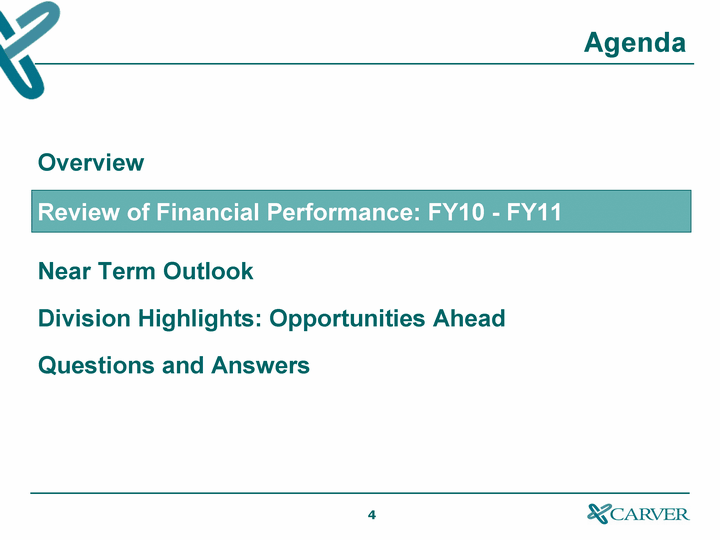
| Agenda Overview Near Term Outlook Division Highlights: Opportunities Ahead Questions and Answers Review of Financial Performance: FY10 - FY11 |
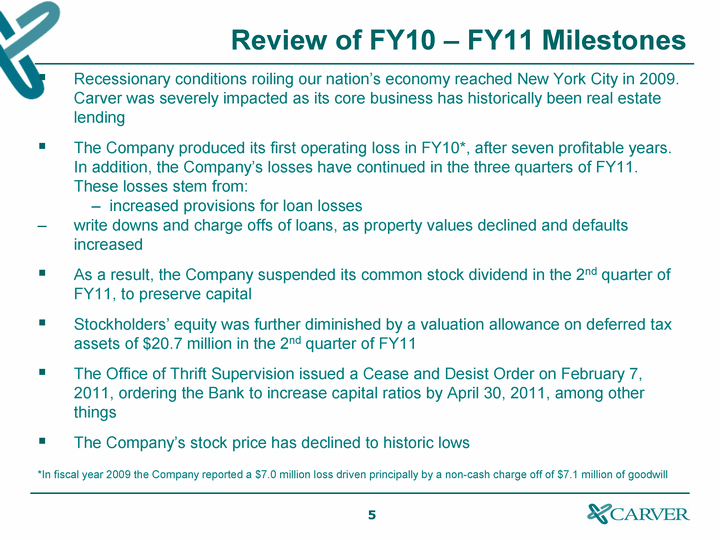
| Recessionary conditions roiling our nation's economy reached New York City in 2009. Carver was severely impacted as its core business has historically been real estate lending The Company produced its first operating loss in FY10*, after seven profitable years. In addition, the Company's losses have continued in the three quarters of FY11. These losses stem from: increased provisions for loan losses write downs and charge offs of loans, as property values declined and defaults increased As a result, the Company suspended its common stock dividend in the 2nd quarter of FY11, to preserve capital Stockholders' equity was further diminished by a valuation allowance on deferred tax assets of $20.7 million in the 2nd quarter of FY11 The Office of Thrift Supervision issued a Cease and Desist Order on February 7, 2011, ordering the Bank to increase capital ratios by April 30, 2011, among other things The Company's stock price has declined to historic lows *In fiscal year 2009 the Company reported a $7.0 million loss driven principally by a non-cash charge off of $7.1 million of goodwill Review of FY10 - FY11 Milestones |

| In the face of this challenging backdrop, some notable accomplishments were achieved during this period The Company maintained a strong net interest margin of 3.92% in FY10 and 3.79% in FY11* The efficiency ratio improved to 88.5% in FY10, the lowest since FY06 Core deposits have increased 12.4%** The Company exchanged the Treasury's TARP investment for Community Development Capital Initiative funds (CDCI) in the 3rd quarter of FY11, which reduced dividend expense by approximately $569,000 annually We continue to be an active participant in the New Markets Tax Credit Program, (NMTC) which we have invested in developments and businesses designed to boost economic activity in highly distressed communities in and around our neighborhoods Our $124 million in total NMTC allocations have contributed $8.3 million to Carver's stockholder equity this year. NMTCs have allowed us to attract approximately $200 million in additional private capital for investment in Low and Moderate Income Communities. * As of December 31, 2010 ** From March 31, 2009 to December 31, 2010 Review of FY10 - FY11 Milestones |
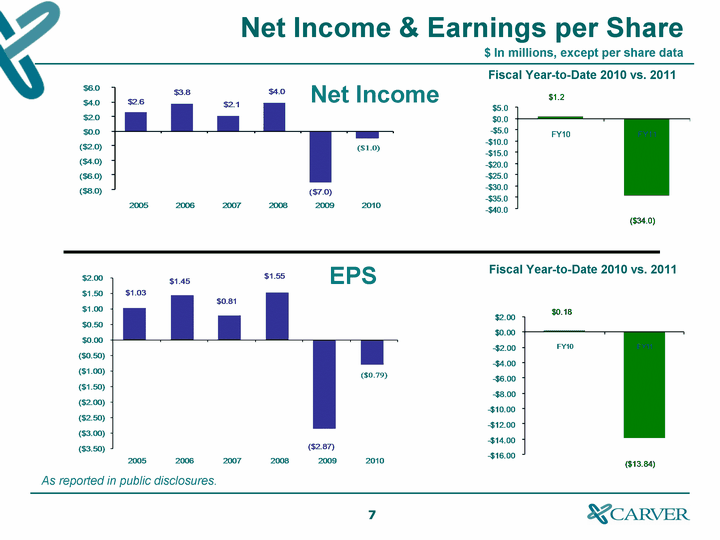
| $ In millions, except per share data Net Income & Earnings per Share As reported in public disclosures. Fiscal Year-to-Date 2010 vs. 2011 EPS Net Income Fiscal Year-to-Date 2010 vs. 2011 |

| Total Net Loans, Deposits and Assets $ In millions As reported in public disclosures. |
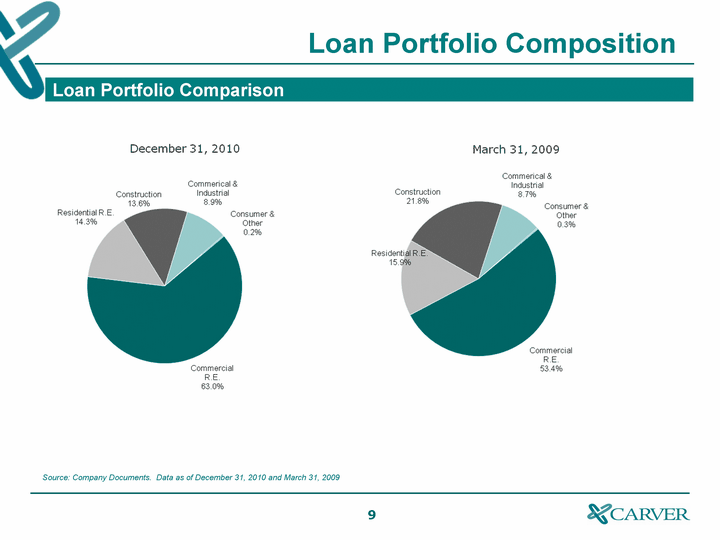
| Source: Company Documents. Data as of December 31, 2010 and March 31, 2009 Loan Portfolio Composition Loan Portfolio Comparison |
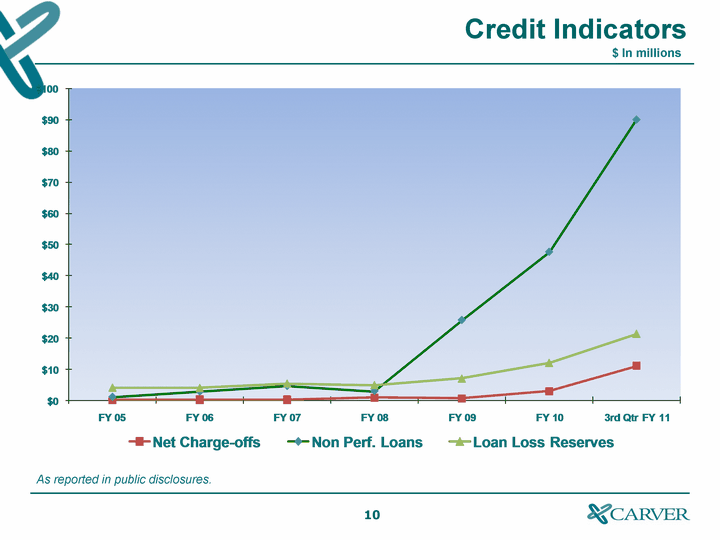
| Credit Indicators $ In millions As reported in public disclosures. |
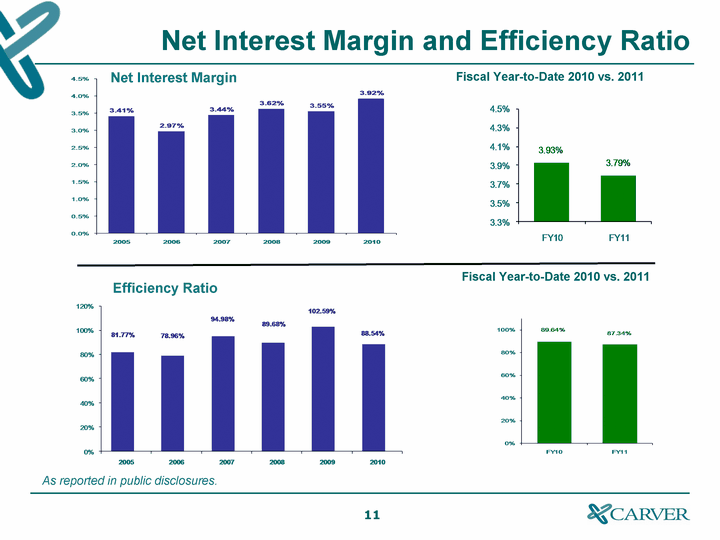
| Net Interest Margin and Efficiency Ratio As reported in public disclosures. Fiscal Year-to-Date 2010 vs. 2011 Net Interest Margin Efficiency Ratio Fiscal Year-to-Date 2010 vs. 2011 |
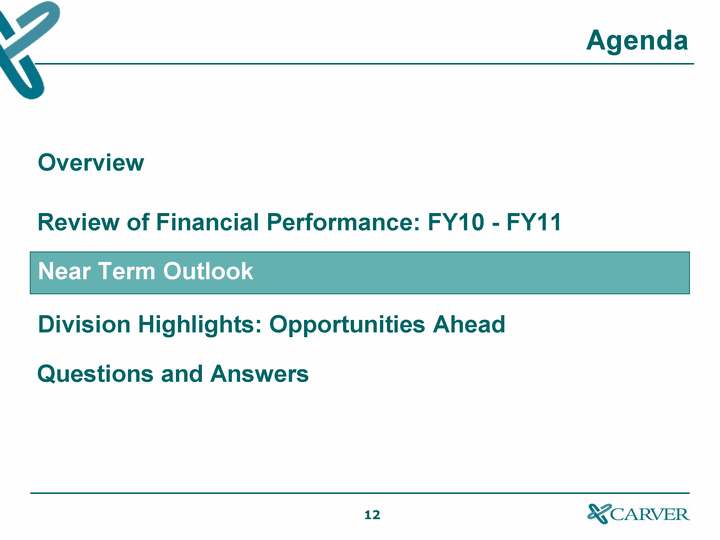
| Agenda Overview Near Term Outlook Division Highlights: Opportunities Ahead Questions and Answers Review of Financial Performance: FY10 - FY11 |
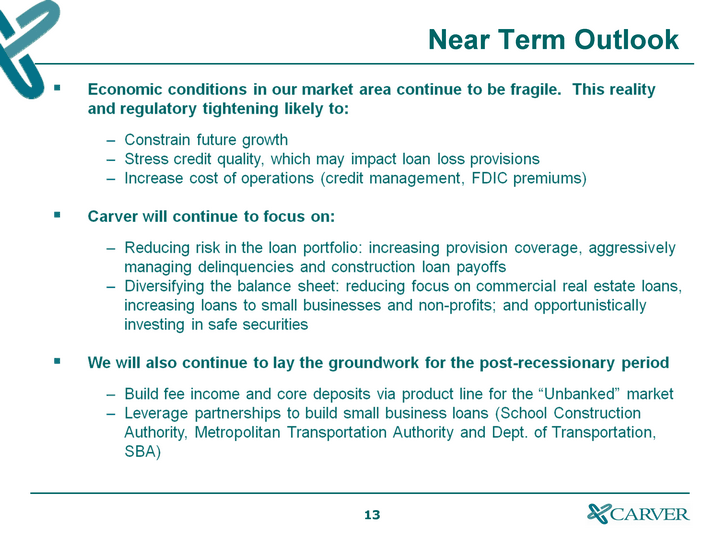
| Near Term Outlook |

| Agenda Overview Near Term Outlook Division Highlights: Opportunities Ahead Review of Financial Performance: FY10 - FY11 Questions and Answers |
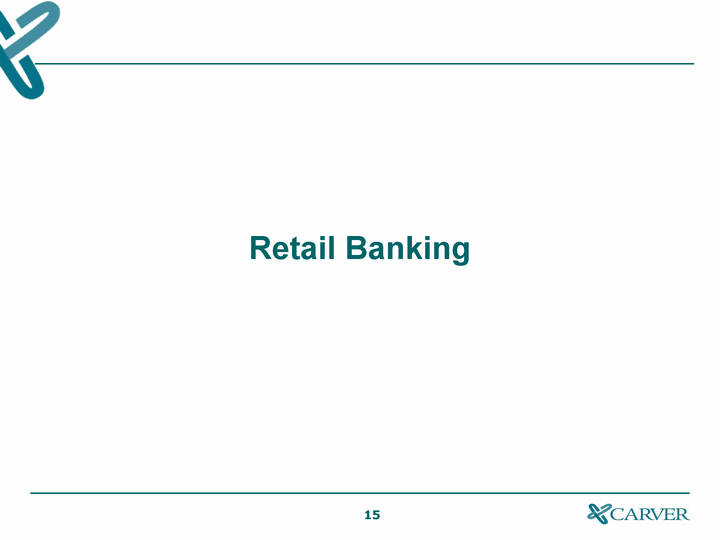
| Retail Banking |
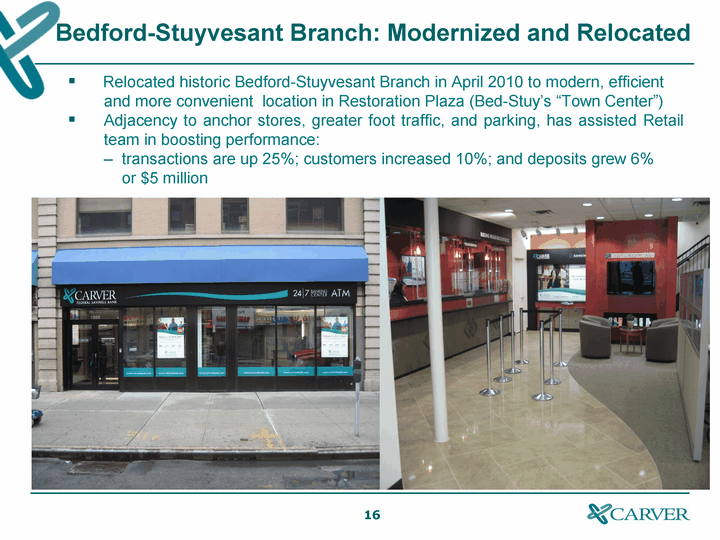
| Bedford-Stuyvesant Branch: Modernized and Relocated Relocated historic Bedford-Stuyvesant Branch in April 2010 to modern, efficient and more convenient location in Restoration Plaza (Bed-Stuy's "Town Center") Adjacency to anchor stores, greater foot traffic, and parking, has assisted Retail team in boosting performance: transactions are up 25%; customers increased 10%; and deposits grew 6% or $5 million |

| Opened First Branch in Flatbush, Brooklyn Expanding Presence in the Caribbean Community Branch opened March 2010 Acquired 1,200 new customers YTD with balances of $12 million Carver Community Cash launched March 2011 |
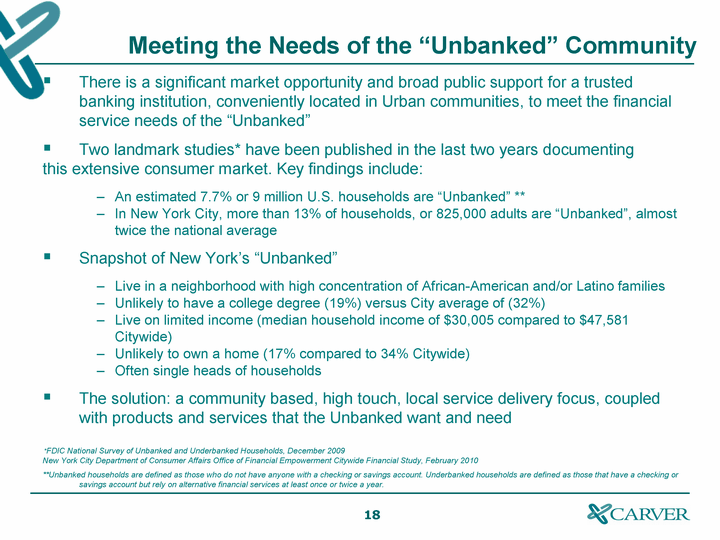
| Meeting the Needs of the "Unbanked" Community There is a significant market opportunity and broad public support for a trusted banking institution, conveniently located in Urban communities, to meet the financial service needs of the "Unbanked" Two landmark studies* have been published in the last two years documenting this extensive consumer market. Key findings include: An estimated 7.7% or 9 million U.S. households are "Unbanked" ** In New York City, more than 13% of households, or 825,000 adults are "Unbanked", almost twice the national average Snapshot of New York's "Unbanked" Live in a neighborhood with high concentration of African-American and/or Latino families Unlikely to have a college degree (19%) versus City average of (32%) Live on limited income (median household income of $30,005 compared to $47,581 Citywide) Unlikely to own a home (17% compared to 34% Citywide) Often single heads of households The solution: a community based, high touch, local service delivery focus, coupled with products and services that the Unbanked want and need *FDIC National Survey of Unbanked and Underbanked Households, December 2009 New York City Department of Consumer Affairs Office of Financial Empowerment Citywide Financial Study, February 2010 **Unbanked households are defined as those who do not have anyone with a checking or savings account. Underbanked households are defined as those that have a checking or savings account but rely on alternative financial services at least once or twice a year. |

| Introducing: Carver Community Cash |

| Carver Community Cash: Prepaid Reloadable Debit Card |
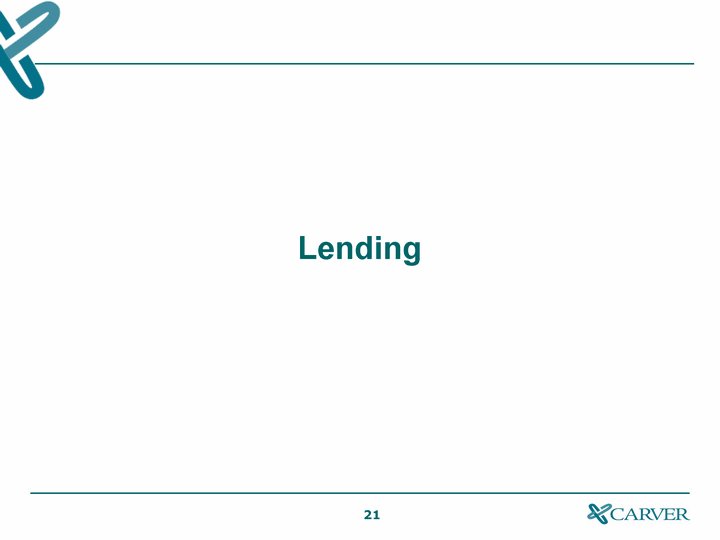
| Lending |

| Lending: Bringing Capital to Small Businesses Carver has built a specialty in lending to MWBE small contractors in our community, over the last three years School Construction Authority (SCA) Carver has provided more than $7.1 million to over 106 minority and women owned contractors through SCA's Mentoring Program which is regarded as the premier capital access program in the region Loan amounts per assignment were increased from $75,000 to $150,000 Not a single loan has been delinquent or lost, due to the Program's design (two- party checks) close monitoring and technical assistance by both the SCA's construction team and Carver's small business lending team Metropolitan Transportation Authority (MTA) In 2009 Carver was selected to serve as exclusive capital access lender for the Small Business Mentor Program sponsored by the MTA. Carver will provide: Short-term small business loans up to $150,000 to support contract mobilization for participating minority businesses Technical Assistance Department of Transportation (DOT) In August 2010, Carver was selected to provide loans to contractors on federal transportation projects in New York. Carver will provide: Short-term small business loans up to $150,000 to support contract mobilization for participating minority businesses |
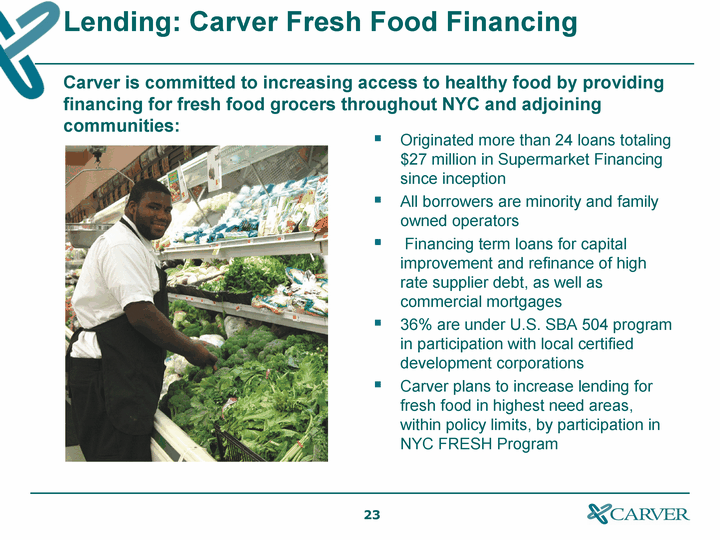
| Lending: Carver Fresh Food Financing Carver is committed to increasing access to healthy food by providing financing for fresh food grocers throughout NYC and adjoining communities: Originated more than 24 loans totaling $27 million in Supermarket Financing since inception All borrowers are minority and family owned operators Financing term loans for capital improvement and refinance of high rate supplier debt, as well as commercial mortgages 36% are under U.S. SBA 504 program in participation with local certified development corporations Carver plans to increase lending for fresh food in highest need areas, within policy limits, by participation in NYC FRESH Program |

| Lending: Small Business Financing Carver is committed to increase our efforts to reach borrowers that have limited access to traditional Bank financing by: Re-establishment of Carver as a SBA 7A Preferred Lender Continue to source and identify prospects from various industries that may qualify for SBA 504 financing Broaden partnership with New York Business Development Corporation (NYBDC) & other local CDCs Develop secondary market relationships to manage exposure, distribute risk, and generate additional fee income |

| Carver Community Development Corp. |
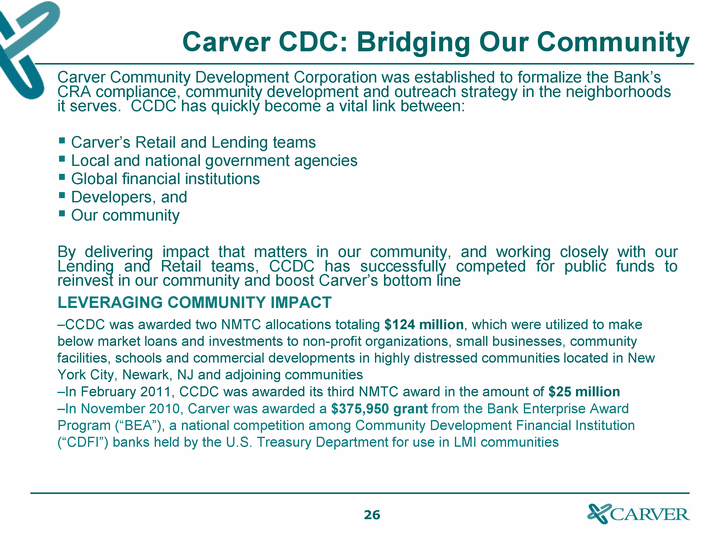
| Carver CDC: Bridging Our Community Carver Community Development Corporation was established to formalize the Bank's CRA compliance, community development and outreach strategy in the neighborhoods it serves. CCDC has quickly become a vital link between: Carver's Retail and Lending teams Local and national government agencies Global financial institutions Developers, and Our community By delivering impact that matters in our community, and working closely with our Lending and Retail teams, CCDC has successfully competed for public funds to reinvest in our community and boost Carver's bottom line LEVERAGING COMMUNITY IMPACT CCDC was awarded two NMTC allocations totaling $124 million, which were utilized to make below market loans and investments to non-profit organizations, small businesses, community facilities, schools and commercial developments in highly distressed communities located in New York City, Newark, NJ and adjoining communities In February 2011, CCDC was awarded its third NMTC award in the amount of $25 million In November 2010, Carver was awarded a $375,950 grant from the Bank Enterprise Award Program ("BEA"), a national competition among Community Development Financial Institution ("CDFI") banks held by the U.S. Treasury Department for use in LMI communities |
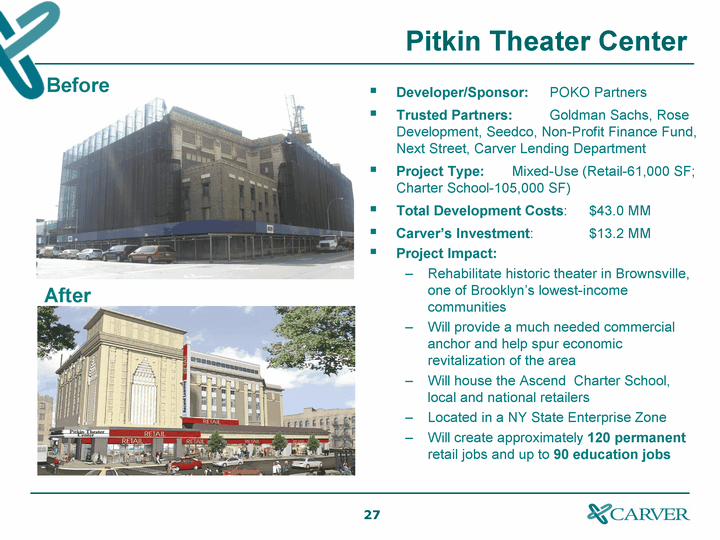
| Pitkin Theater Center Pitkin Theater Center Developer/Sponsor: POKO Partners Trusted Partners: Goldman Sachs, Rose Development, Seedco, Non-Profit Finance Fund, Next Street, Carver Lending Department Project Type: Mixed-Use (Retail-61,000 SF; Charter School-105,000 SF) Total Development Costs: $43.0 MM Carver's Investment: $13.2 MM Project Impact: Rehabilitate historic theater in Brownsville, one of Brooklyn's lowest-income communities Will provide a much needed commercial anchor and help spur economic revitalization of the area Will house the Ascend Charter School, local and national retailers Located in a NY State Enterprise Zone Will create approximately 120 permanent retail jobs and up to 90 education jobs Before After |
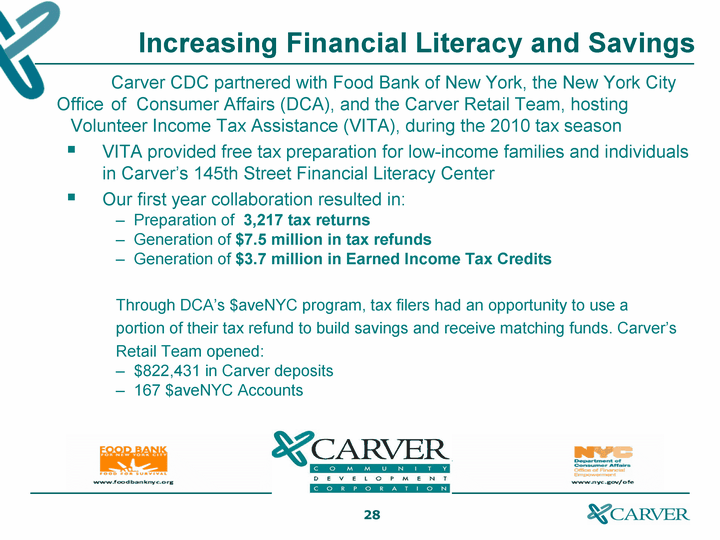
| Increasing Financial Literacy and Savings Carver CDC partnered with Food Bank of New York, the New York City Office of Consumer Affairs (DCA), and the Carver Retail Team, hosting Volunteer Income Tax Assistance (VITA), during the 2010 tax season VITA provided free tax preparation for low-income families and individuals in Carver's 145th Street Financial Literacy Center Our first year collaboration resulted in: Preparation of 3,217 tax returns Generation of $7.5 million in tax refunds Generation of $3.7 million in Earned Income Tax Credits Through DCA's $aveNYC program, tax filers had an opportunity to use a portion of their tax refund to build savings and receive matching funds. Carver's Retail Team opened: $822,431 in Carver deposits 167 $aveNYC Accounts |
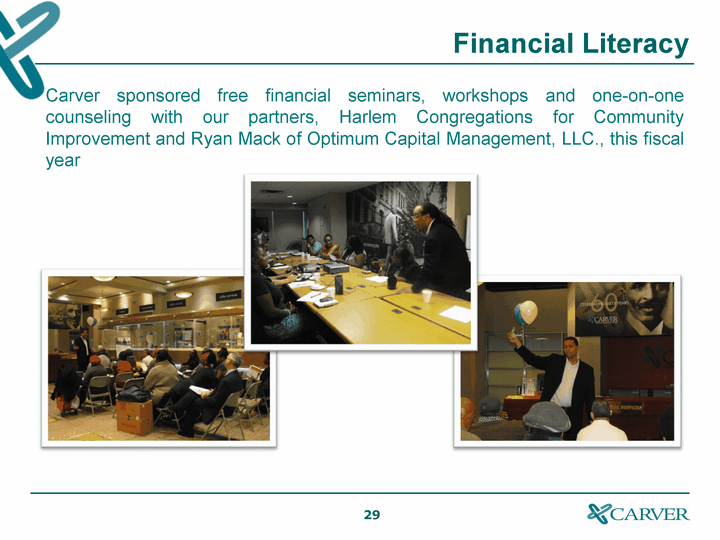
| Financial Literacy Financial Literacy Financial Literacy Carver sponsored free financial seminars, workshops and one-on-one counseling with our partners, Harlem Congregations for Community Improvement and Ryan Mack of Optimum Capital Management, LLC., this fiscal year |
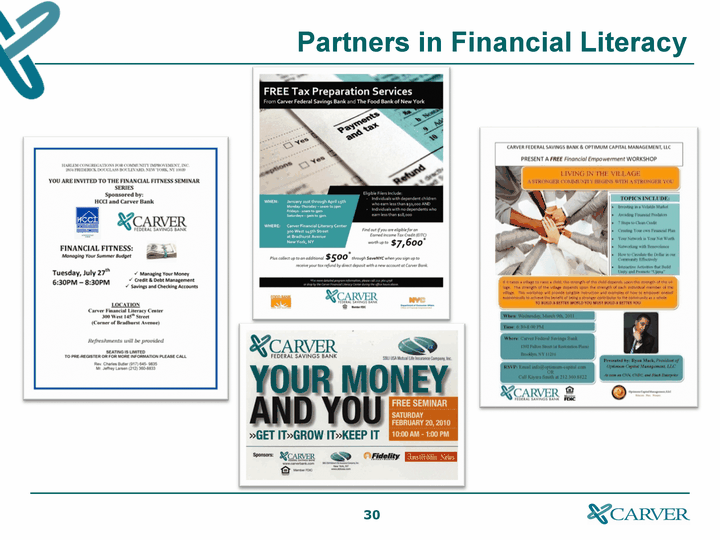
| Partners in Financial Literacy Partners in Financial Literacy Partners in Financial Literacy |
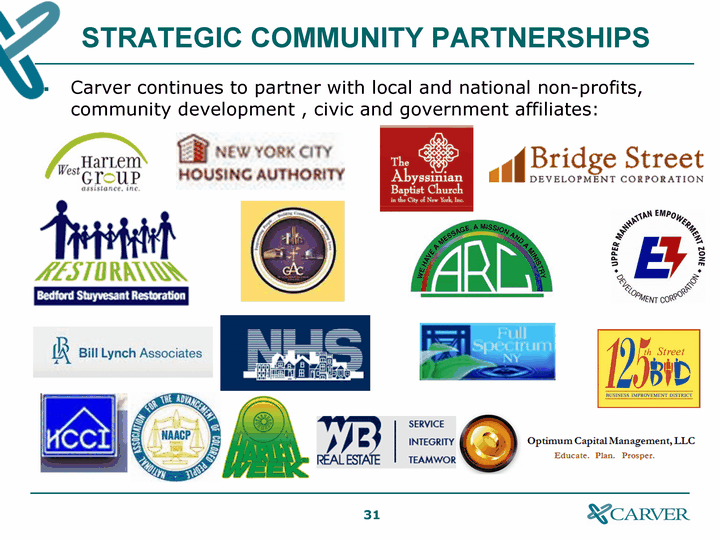
| STRATEGIC COMMUNITY PARTNERSHIPS Carver continues to partner with local and national non-profits, community development , civic and government affiliates: |

| Agenda Overview Near Term Outlook Division Highlights: Opportunities Ahead Questions and Answers Review of Financial Performance: FY10 - FY11 |

